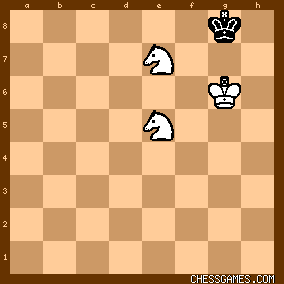Feb-14-14
 | | FSR: Apparently White should have won this. See https://en.wikipedia.org/wiki/Troit.... But obviously it hadn't been given the tablebases for how to handle the ending, and it was too deep for it to calculate over the board. |
|
| Feb-14-14 | | DaringSpeculator: <FSR: Apparently White should have won this. See https://en.wikipedia.org/wiki/Troit.... But obviously it hadn't been given the tablebases for how to handle the ending, and it was too deep for it to calculate over the board.> The position after 54...e5 is a tablebase draw, because, even without invoking the 50-move rule, the black's pawn cannot be blockaded by one of white's knights before it reaches e3! 
click for larger view |
|
| Feb-14-14 | | SChesshevsky: My questions is why did they continue play after 104. Nxe4? Are the computers on automatic pilot or did the operator fall asleep? |
|
Feb-15-14
 | | FSR: <DaringSpeculator> OK, but Black kindly let the pawn be blockaded on e4. |
|
| Feb-15-14 | | morfishine: Here's whats way beyond my horizon: After 60.Ke3, White has the simple maneuver 61.Nf7, 62.Ng5 then 63.Nxe3 Instead, White's Knights commence a series of long-winded and convoluted maneuvers, not even bothering to take the pawn for 44 moves Now after 61.Nf7 Kc2 62.Ng5 Kd1 63.Nxe4

click for larger view
Isn't White winning here with Black to move 63?
***** |
|
| Feb-15-14 | | nimh: Interesting, by clicking on the link by FSR I landed here: https://en.wikipedia.org/wiki/Troit... But DaringSpeculator's link for some reason and despite being the same sent me there: https://en.wikipedia.org/wiki/Troit |
|
Feb-15-14
 | | FSR: <morfishine> The whole point of the two knights versus pawn ending is to <not> take the pawn, since K+NN can't force mate against a lone king. Instead, the side with the knights uses one knight to blockade the opponent's pawn, then tries to use the king and the other knight to maneuver the king into a corner. If this can be achieved, and the pawn is not too far advanced, the remaining knight can then come over and checkmate the cornered king. See the decisive games in this collection for an idea of how it's done: Endgame Explorer: NN vs P If the superior side instead <takes> the opponent's pawn, then the ending is a trivial draw. All the inferior side has to do is avoid falling into mate in one. (Just trying to keep the king as close to the center of the board as possible works equally well.) Here are the two types of positions where mate is possible (but only if the guy with the king blunders): 
click for larger viewIf 1...Kh8??, 2.Nf7#. Instead, 1...Kf8! draws.

click for larger viewIf 1...Ke8??, 2.Nf6#. Instead, 1...Kd7!, 1...Kc7!, and 1...Kc8! all draw. |
|
Feb-15-14
 | | FSR: <nimh> If you put your cursor under my link, you'll see that the periods after "Troit" are highlighted along with everything else. So my link is actually longer than it appears; CG.com just abbreviated it so you don't see the whole thing. If you do the same with <DaringSpeculator>'s link, you'll see that the periods are not highlighted. So that link just goes to https://en.wikipedia.org/wiki/Troit, rather than to the "Troitzky line" section of the "Two knights endgame" article. |
|
| Feb-15-14 | | morfishine: <FSR> Yes, of course, I should've read up on that. For a long time, I think it was agreed that K+2N could not force mate, then it was found they could mate, but only if the opposing side blunders. Its K+B+N that needs to back the opposing King into the correct corner |
|
| Sep-24-14 | | kontoleon: OK BOTH computer have 6 piece endgame tablebase(i am no sure if is legal to use them)(and maybe 7 piece endgame). But still play chess. This is computer. |
|





